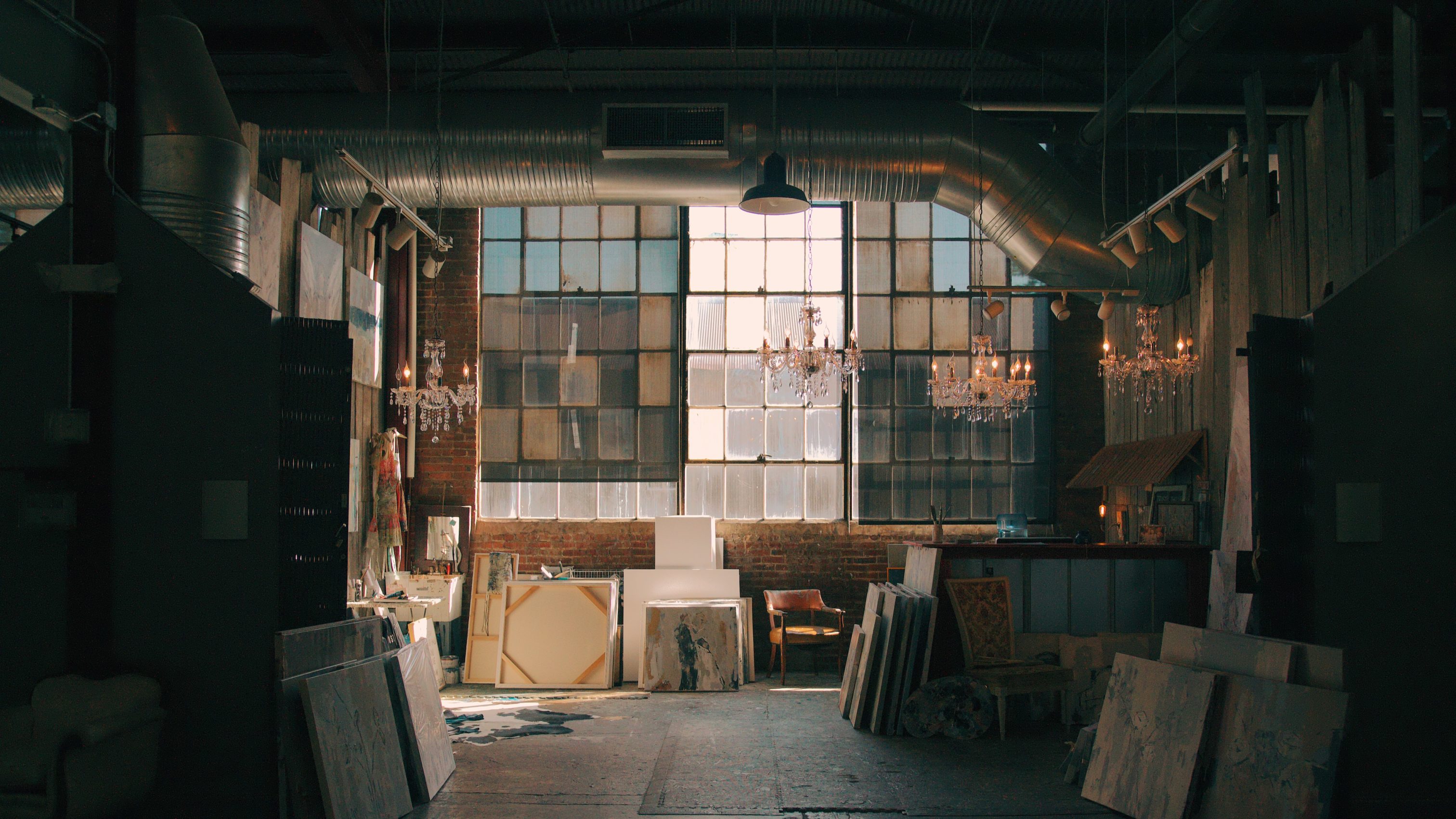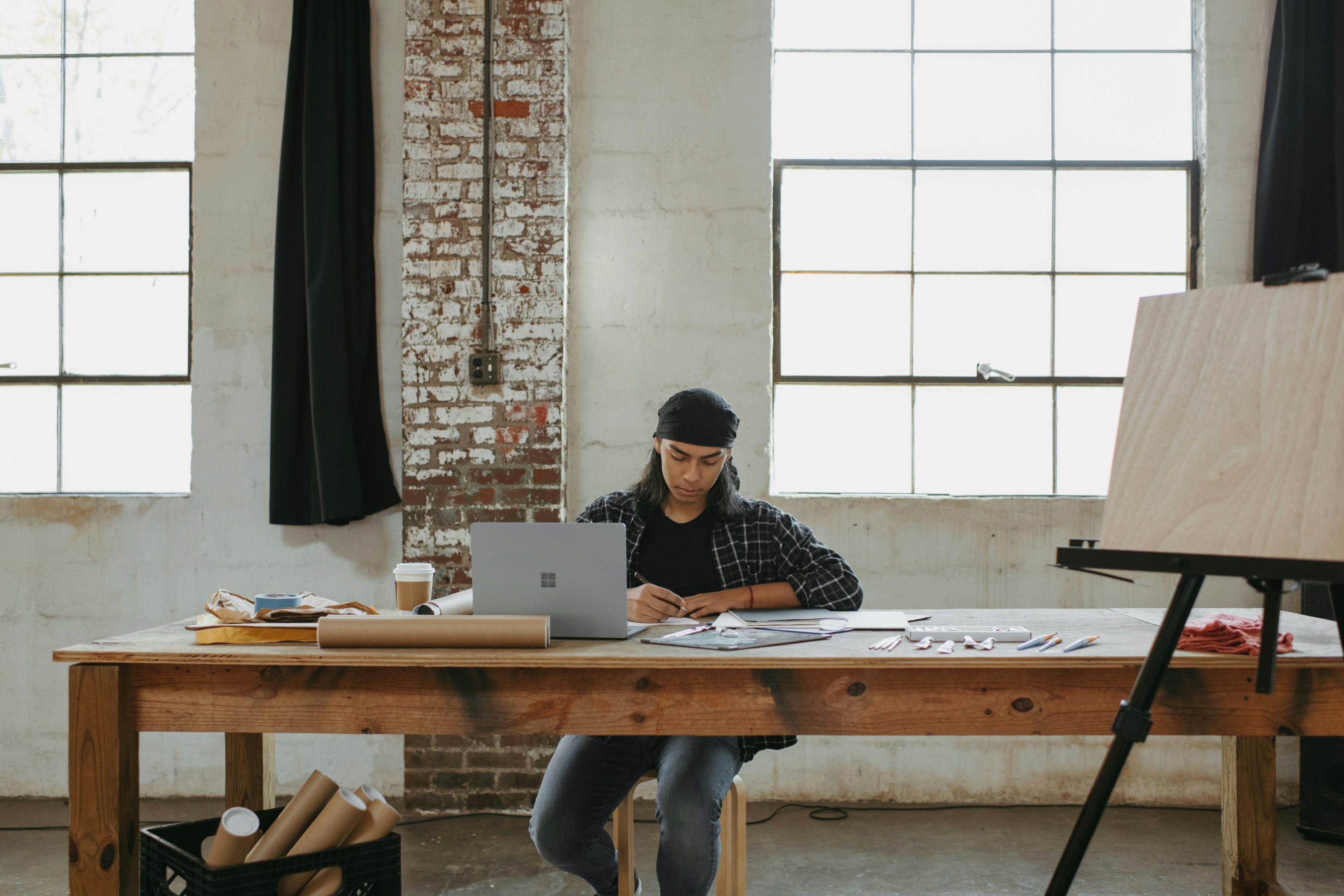How to price your art can be an artist’s most significant challenge. There is no one-size-fits-all formula, so finding the right pricing strategy often involves trial and error. Don’t be afraid to experiment and adjust your prices to see what works best.
Create your Cosimo account today to try our free pricing tool for yourself!
Basic Pricing Structure For Art
As a baseline, many suggest calculating your hourly rate based on how long it took to create the piece plus the cost of materials. However, several other essential factors must be considered when determining your art’s value.
Why Pricing Your Art Matters
Pricing your art isn’t just about covering material costs and labour—it’s about positioning yourself in the market. Here are several reasons why a well-considered pricing strategy is crucial:
1. Establishing Perceived Value
Your price communicates the value of your work. When set correctly, it can enhance your reputation and make your art appear more desirable to collectors. Conversely, low pricing might devalue your creative expression and hinder your ability to live sustainably from your passion. That’s why understanding how to price your art is essential for artistic and financial success.
2. Sustaining Your Art Business
For many artists, income from sales is the primary source of livelihood. A thoughtful pricing strategy ensures that every piece sold contributes to your financial goals. It’s about making ends meet and building a brand that supports future investments in your art practice. Knowing how to price your art effectively is key to sustaining your career and creativity.
3. Building Credibility and Trust
Consistent pricing that reflects your skills, experience, and market demand builds credibility with your audience. Knowing how to price your art effectively signals that you recognise your worth and the value you bring to collectors. This is especially important when establishing long-term relationships with buyers and galleries.
4. Adapting to Market Trends
The art market is dynamic, with trends constantly evolving and collector interests shifting. Understanding how to price your art strategically ensures you can adapt to new developments, such as the rise of NFTs and digital art. A well-planned pricing approach, including periodic adjustments, helps you stay relevant and competitive.
5. Encouraging Consistent Sales
When you understand how to price your art effectively, you make it more likely to sell. Setting a price that balances accessibility with perceived value allows you to reach a broader audience. Consistent sales can also open doors to exhibitions, collaborations, and additional revenue streams, helping you grow as an artist.
Overpricing vs. Underpricing: What You Need to Know
Striking the right balance between overpricing and underpricing is critical. Both extremes carry risks and rewards. Each approach presents challenges and potential benefits, making proper equilibrium essential.
Overpricing: The Risks and Rewards
Risks:
- Alienating Potential Buyers: When your prices are too high, you risk turning away collectors who might be interested in your work if it were priced more reasonably.
- Market Disconnect: Overpricing can create a disconnect with the market, especially if your peers with similar skill levels and experience are pricing lower.
- Longer Time on the Market: Art priced too high may remain unsold, harming your reputation and negatively affecting collectors’ perceptions.
Rewards:
- Perceived Value: Higher prices can signal higher quality and exclusivity. If buyers believe your work is of exceptional quality, they may be willing to pay a premium.
- Sustainability: Adequate pricing ensures you can cover costs and reinvest in your art practice, leading to better long-term sustainability.
- Strategic Positioning: A higher price point in some markets can distinguish you from mass-market creators as a luxury or niche artist.
Underpricing: The Downside of Low Rates
Risks:
- Devaluing Your Work: Pricing your art too low might signal that your work lacks quality or value.
- Financial Strain: Underpricing makes it challenging to cover production costs, invest in better materials, or support yourself as a professional artist.
- Difficulty in Raising Prices: Once you’ve set a low price, it can be challenging to raise it later without alienating existing collectors or devaluing your previous work.
Rewards:
- Increased Accessibility: Lower prices can attract more buyers, making your art accessible to emerging collectors.
- Volume Sales: If you create many pieces or prints, lower individual prices lead to more frequent sales and consistent income.
- Market Entry: Competitive pricing can help new artists establish a presence in the market and build a customer base.
It is essential to find the right balance when determining how to price your art. Your pricing should reflect your unique skills and market demand without compromising long-term career sustainability. The most effective pricing strategy is often dynamic and evolves with your experience and market conditions.
Basic Art Pricing Strategies for Beginners
If you’re just starting out, not knowing how to price your art can make setting a value feel like guesswork. However, some tried-and-true methods can help you develop a baseline.
1. Calculate Your Hourly Rate
One of the simplest ways to start is by calculating your hourly rate. Here’s how you can do it:
- Determine Your Income Goal: Decide how much you need to earn per year to support yourself.
- Estimate Billable Hours: Calculate how many hours per year you realistically spend on creating art that can be sold.
- Calculate Your Rate: Divide your annual income goal by your billable hours. This gives you an introductory hourly rate that reflects your personal financial needs.
Example:
If your annual income goal is £30,000 and you have 1,500 billable hours a year, your hourly rate would be £20 per hour.
2. Add Material and Overhead Costs
Beyond your time, consider the direct costs associated with creating your art:
- Materials: Include the cost of paint, canvas, tools, and other supplies.
- Overheads: Factor in studio rent, utilities, and other recurring expenses.
- Additional Costs: If you sell through galleries or agents, consider expenses such as marketing, framing, shipping, and commissions.
3. Consider the Size and Complexity of the Work
Larger or more intricate pieces often require more time and resources. Adjust your pricing based on:
- Size: Larger canvases or sculptures typically demand higher prices.
- Complexity: More detailed or labour-intensive pieces should command a premium.
- Edition Type: Original artworks are usually priced significantly higher than prints. Due to their scarcity, limited edition prints can justify a higher price than open editions.
4. Start with a Pricing Calculator
While these basic methods provide a good starting point, they can be refined with tools that consider market trends and historical sales data. Our free pricing calculator is an excellent resource for beginners, as it aggregates market data to suggest competitive price ranges based on your unique circumstances.
How to Use Our Art Pricing Calculator to Get Accurate Estimates
Technology simplifies the complex task of pricing your art in 2025. Our free pricing calculator integrates multiple data points to provide competitive estimates tailored to your unique situation. Here’s how to leverage this powerful tool:
Step 1: Input Your Artwork Details
Start by entering key information about your piece:
- Size of Artwork: Select the dimensions from the dropdown menu—larger pieces typically command higher prices
- Hours to Make: Use the slider to indicate your time investment, a crucial factor that directly impacts your pricing
- Edition Type: Specify whether your work is an original, limited edition, or open edition print
- Edition Size: For limited editions, adjust the slider to indicate scarcity—smaller runs generally warrant premium pricing
- Main Medium: Select your primary medium, as certain materials and techniques command different market values

Step 2: Let the Calculator Process Market Data
Behind the scenes, our calculator analyses:
- Comparative Sales Data: Prices of similar works by artists with comparable styles and experience levels
- Current Market Conditions: Latest trends from art fairs, exhibitions, and online sales platforms
- Medium-Specific Pricing: Different expectations for paintings, sculptures, digital art, and other formats
Step 3: Receive Your Recommended Price Range
After clicking “Calculate,” you’ll receive a data-backed price recommendation that:
- Reflects current market expectations for your type of work
- Considers your unique artistic factors and production costs
- Provides a range that allows flexibility while remaining competitive
Step 4: Refine and Adjust
While our calculator delivers a solid foundation, remember that pricing is both an art and a science:
- Trust Your Instincts: Does the recommended price align with the value you place on your work?
- Collect Feedback: Note how potential buyers respond to your pricing strategy.
- Iterate Over Time: Regularly revisit your pricing as your reputation grows and market conditions evolve.
This calculator embodies the pricing principles discussed throughout this guide—balancing cost considerations with market positioning and perceived value. While no tool can replace your judgment as an artist, our calculator provides a solid foundation for pricing decisions backed by real market intelligence.
To access this valuable tool, simply complete the required fields on the CV Builder page of your Cosimo account. Create your free account today to start pricing your artwork with confidence!
Advanced Pricing Strategies for Professional Artists
As your career develops, you may need to adopt more sophisticated pricing strategies that reflect your growing reputation and evolving market trends. Here are some advanced methods to consider:
1. Value-Based Pricing
Value-based pricing focuses on the perceived value of your art rather than just the costs incurred. This method takes into account:
- Brand Value: How your reputation and past sales influence perceived value.
- Collector Demand: What collectors are willing to pay for your work based on its uniqueness and artistic merit.
- Market Comparisons: Prices of similar works by artists with comparable backgrounds and experiences.
2. Dynamic Pricing
Dynamic pricing is an adaptive strategy that responds to real-time market data and trends. For example, during art fairs or exhibitions, you might temporarily adjust your prices to reflect increased demand or heightened exposure.
3. Incorporating Scarcity and Exclusivity
Scarcity can significantly influence pricing. Limited edition works, or pieces from a small series, can command higher prices due to their exclusivity. Consider:
- Edition Size: Smaller editions typically increase the perceived value.
- Exclusivity Clauses: Offering exclusive rights to specific buyers can justify a higher price point.
4. Bundling and Tiered Pricing
For artists with a range of works, bundling multiple pieces together or offering tiered pricing options can be an effective strategy. This might include:
- Series Collections: Pricing a series of works at a bundled discount.
- Tiered Options: Offering basic prints at one price, with premium options (e.g., signed, framed, or numbered editions) at a higher rate.
5. Long-Term Pricing Strategy
Your pricing strategy should evolve as you build your portfolio and gain recognition. Regularly review:
- Sales Data: Analyse which pieces sell well and at what price points.
- Collector Feedback: Solicit feedback from buyers to understand their perception of value.
- Market Trends: Stay updated with trends, including the rising influence of digital art and NFTs, which can impact traditional pricing models.

Factors That Influence How to Price Your Art
Education Level
If you have an undergraduate or graduate art degree, you can typically charge more than self-taught artists. After all, you invested your time and money into gaining such qualifications, so your customers are likely to be willing to pay a premium for the skills you gained.
Years of Experience
The longer you’ve been a practising artist, the more you can charge for your work. As with any industry, if you’re perceived to be an expert at what you do, which often comes with experience over time, you can and should charge more for this insight.
Exhibition History
Have you shown your art at major galleries or fairs? The calibre of exhibitions you’ve participated in can raise your prices. Look at what other exhibiting artists charge when you are at group shows or art fairs – this should help guide your pricing in the broader market.
Number of Sales
If you produce fewer original pieces each year, you’ll need to charge more per artwork to meet your financial goals. Adjust accordingly.
For example, if you can only produce a handful of large-scale works in a single year, you will need to charge more for those pieces than if you could make and sell hundreds of smaller artworks in the same period.

Number of Sales
If you produce fewer original pieces each year, you’ll need to charge more per artwork to meet your financial goals. Adjust accordingly.
For example, if you can only produce a handful of large-scale works in a single year, you will need to charge more for those pieces than if you could make and sell hundreds of smaller artworks in the same period.
Original vs Print
There’s a big difference in pricing for original works vs prints. Limited edition prints can be priced higher than open editions due to scarcity. As a rule of thumb, if you sell a limited edition print for £X, the original should be priced around 20X for 20 prints.
Common Mistakes to Avoid When Pricing Your Art
Avoid these pitfalls to maintain credibility and profitability:
- Ignoring Total Costs: Materials, studio rent, utilities, framing, marketing, shipping, and gallery commissions contribute to your bottom line.
- Neglecting Market Research: Failing to compare prices of similar artists leaves you out of alignment with collector expectations.
- Static Pricing: Not revisiting prices annually means missing out on increased demand or rising material costs.
- Overemphasis on Cost-Plus: Relying solely on cost-plus methods overlooks intangible value like brand reputation.
- Undervaluing Editions: Treating originals and prints identically ignores scarcity’s impact on price.
- Poor Communication: Without clear pricing tiers (e.g., sizes, editions), buyers can feel confused or mistrustful.
By proactively addressing these errors, you’ll present transparent, fair, and sustainable pricing.
Keep It Simple
The simplest way to price your work is to consider your financial needs, what comparable artists charge, and what your typical collector is willing to pay. Break it down into manageable parts.
Maintaining flexibility in your pricing strategy is key, as you may need to adjust based on market demand, changes in material costs, or shifts in your artistic output over time. After all, if your work is sitting in the studio gathering dust and someone makes a reasonable offer, you might not want to get too hung up on a few quid here and there!

You can make informed decisions about effectively pricing your artwork by weighing the above factors. It may take some adjusting, but you’ll eventually find the pricing sweet spot. Consistently re-evaluating your prices ensures that you stay competitive while maximising the value of your creative work.
Best of all, as a Cosimo member, you can sign up and use our data-driven pricing calculator for FREE. This tool uses accurate market data to tailor pricing recommendations based on your circumstances.
FAQs
The most effective art pricing strategy in 2025 combines a cost-plus approach (materials + time + profit margin) with value-based pricing that reflects market demand, brand credibility, and uniqueness. Tools like Cosimo’s pricing calculator help tailor prices using real-time market data.
A pricing calculator factors in your costs, time, and industry benchmarks to suggest competitive price ranges. It helps eliminate guesswork and ensures your prices reflect your experience and the current art market.
Key factors include your experience, education, sales history, exhibition record, market demand, and whether the work is an original or a print. Size, complexity, and edition type also affect pricing.
Beginner artists may start with more accessible pricing to enter the market, but it should still reflect their time, materials, and unique value. Underpricing can lead to long-term challenges.
Overpricing can lead to unsold inventory, market disconnect, and missed opportunities—but in the proper context, it can also signal exclusivity and elevate perceived value.
Original artworks are priced higher due to their uniqueness. Limited edition prints have added value due to scarcity, while open edition prints are priced lower for wider accessibility.
Account for all expenses (materials, time, studio costs), compare your work to similar artists, and use tools like Cosimo’s calculator to ensure your pricing reflects quality and effort.

